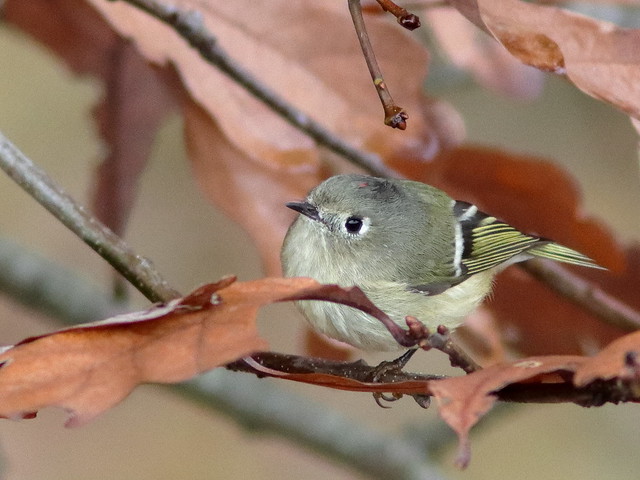A week of mild weather has encouraged outside activity. The trees have lost most of their leaves and the understory in the adjacent woodlands is carpeted by dry leaves bathed in dappled sunlight.
News of a population explosion of northern finches raises our hope of seeing them locally. There have been several visits by Purple Finches. On October 28 this female posed nicely:
Then, on the first of November a group of 4-6 briefly appeared in the back yard. I missed a photo opportunity when a beautiful male briefly landed on the fence, but flew away the instant I reached for my camera. They spent most of their time in the tree tops and did not visit the feeders.
My photos were soft because of the distance and lighting challenges.
Male Purple Finch:
Female and male pair:
A few White-throated Sparrows have appeared. There are two morphs, with either white or tan eye stripes. The white-striped individuals also tend to have more intense gray cheeks and upper breast, while the tan-striped birds have a less contrasting face and chest pattern and usually stronger streaking on breast and flanks. Interestingly, members of one morph, whether male or female, usually mate with one of the opposite morph. When I was a kid birder the consensus was that those with dull tan stripes were immature birds.
This is a white-striped individual...
...while this one has the tan eye stripe:
For some reason, Northern Cardinals have been rather scarce lately, but this past two weeks we have been seeing them regularly:
A Ruby-crowned Kinglet was difficult to find as it searched for insects among the leaves. The red feathers on its head distinguishes it as a male:
It briefly flew into full view:
MaryLou and I, along with our granddaughter Graci, took a delightful walk along the Longo Trail which passes by our back yard. This was first time I attempted to negotiate this trail, as it must be accessed by bush-whacking from the top of the cliff in back of the house through brush and boulders down a steep grade, descending about 100 feet/30 m of elevation over a course of about 120 feet/37 m (average 33 degrees of slope). The fence at the top of the cliff marks the edge of the back lawn.
Our home was barely visible when we reached the trail:
This is a crop of the above photo to show the view of the big house "La Casona:"
Graci was our trail-blazer as we threaded our way down between boulders and deadfalls. Once we set foot on the trail we found it to be quite level and well-maintained. The route was usually obvious and marked by yellow blazes, but the actual track was deeply covered by fallen leaves which hid some pits and rocks.
The mixed hardwood forest understory was quite open. Oaks and scattered birch trees exhibited rich autumn color:
A few days earlier I watched a younger White-tailed doe lick wounds on the face, neck and shoulders of another, possibly her mother, who also had some lacerations on her hind quarters. None were bleeding and may have been several days old. Coyotes or a Black Bear may have inflicted the injuries. The injured deer was grazing and moving about, but I have not seen her since:
On October 23 there was an odd and dazzling sunset, as concentric circular cloud layers appeared to surround the sun just before it disappeared:
By late October, brown had become the dominant color along the lake:
We enjoyed clear skies for the total eclipse of the Beaver Moon on Tuesday morning, November 8th. I captured this sequence from 4:10 AM until the sky brightened up as the Moon disappeared into the morning haze at 5:47 AM. Canon 90D Lens EF300mm f/4L IS USM +1.4x, [420 mm system] Handheld:
= = = = = = = = = = = = = = =My Corner of the World
________________________________________________
Please visit the links to all these posts to see some excellent photos on display
________________________________________________





















































